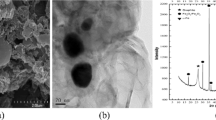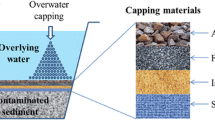Abstract
The management of dredged sediments is an important issue in coastal regions where the marine sediments are highly polluted by metals and organic pollutants. In this paper, mineral-based amendments (hematite, zero-valent iron and zeolite) were used to stabilize metallic pollutants (As, Cd, Cu, Mo, Ni, Pb, and Zn) in a contaminated marine sediment sample. Mineral-based amendments were tested at three application rates (5 %, 10 %, and 15 %) in batch experiments in order to select the best amendment to perform column experiments. Batch tests have shown that hematite was the most efficient amendment to stabilize inorganic pollutants (As, Cd, Cu, Mo, Ni, Pb, and Zn) in the studied sediment. Based on batch tests, hematite was used at one application rate equal to 5 % to conduct column experiments. Column tests confirmed that hematite was able to decrease metal concentrations in leachates from stabilized sediment. The stabilization rates were particularly high for Cd (67 %), Mo (80 %), and Pb (90 %). The Microtox solid phase test showed that hematite could decrease significantly the toxicity of stabilized sediment. Based on batch and column experiments, it emerged that hematite could be a suitable adsorbent to stabilize metals in dredged marine sediment.

Similar content being viewed by others
References
Alzieu C (1999) Dragages et environnement marin: état des connaissances. IFREMER, Nantes
Alzieu C, Quiniou F (2001) Geodrisk, in CD-ROM Geodrisk "Software to assess risks related to dumping of dredged sediments from maritime harbours"
Azur Environmental (1998) Microtox acute toxicity test guide, user’s manual. Azur Environmenta, Carlsbad
Bortone G, Arevalo E, Deibel I, Detzner H-D, de Propris L, Elskens F et al (2004) Synthesis of the sednet work package 4 outcomes. J Soil Sediment 4:225–232
Caille N, Tiffreau C, Leyval C, Morel JL (2003) Solubility of metals in an anoxic sediment during prolonged aeration. Sci Total Environ 301:239–250
Caplat C, Texier H, Barillier D, Lelievre C (2005) Heavy metals mobility in harbour contaminated sediments: the case of Port-en-Bessin. Mar Pollut Bull 50:504–511
Cappuyns V, Swennen R, Devivier A (2006) Dredged river sediments: potential chemical time bombs? A case study. Water Air Soil Pollut 171:49–66
Cornell RM, Schwertmann U (2003) The iron oxides (structure, properties, occurrences and uses). Wiley, Weinheim
European Council (2002) Council decision of 19 December 2002 establishing criteria and procedures for the acceptance of waste at landfills pursuant to Article 16 of Annex II to Directive 1999/31/EC(2003/33/EC) (Official Journal of European Communities L11/27 [1612003])
Fang Y, Cao X, Zhao L (2012) Effects of phosphorus amendments and plant growth on the mobility of Pb, Cu, and Zn in a multi-metal-contaminated soil. Environ Sci Pollut Res 19:1659–1667
Grosdemange D, Leveque F, Drousie D, Aqua JL, Mehu J, Bazin C (2008) The SEDIMARD project: presentation and results. In: International Symposium on Sediment Management–I2SM. Lille (France)
Guo G, Zhou Q, Ma L (2006) Availability and assessment of fixing additives for the in situ remediation of heavy metal contaminated soils: a review. Environ Monit Assess 116:513–528
Hage JLT, Mulder E (2004) Preliminary assessment of three new European leaching tests. Waste Manage 24:165–172
Kosson DS, van der Sloot HA, Eighmy TT (1996) An approach for estimation of contaminant release during utilization and disposal of municipal waste combustion residues. J Hazard Mater 47:43–75
Kumpiene J, Lagerkvist A, Maurice C (2008) Stabilization of As, Cr, Cu, Pb and Zn in soil using amendments—a review. Waste Manage 28:215–225
Lafabrie C, Pergent-Martini C, Pergent G (2008) Metal contamination of Posidonia oceanica meadows along the Corsican coastline (Mediterranean). Environ Pollut 151:262–268
Libralato G, Losso C, Arizzi Novelli A, Citron M, Della Sala S, Zanotto E et al (2008) Ecotoxicological evaluation of industrial port of Venice (Italy) sediment samples after a decontamination treatment. Environ Pollut 156:644–650
Lions J, van der Lee J, Guérin V, Bataillard P, Laboudigue A (2007) Zinc and cadmium mobility in a 5-year-old dredged sediment deposit: experiments and modelling. J Soil Sediment 7:207–215
Mamindy-Pajany Y, Hurel C, Marmier N, Roméo M (2009) Arsenic adsorption onto hematite and goethite. CR Chim 12:876–881
Mamindy-Pajany Y, Libralato G, Roméo M, Hurel C, Losso C, Ghirardini AV et al (2010a) Ecotoxicological evaluation of Mediterranean dredged sediment ports based on elutriates with oyster embryotoxicity tests after composting process. Water Res 44:1986–1994
Mamindy-Pajany Y, Galgani F, Roméo M, Hurel C, Marmier N (2010b) Minerals as additives for decreasing the toxicity of Mediterranean contaminated dredged sediments. Ecotoxicol Environ Saf 73:1748–1754
Mamindy-Pajany Y, Hamer B, Roméo M, Géret F, Galgani F, Durmisi E et al (2011) The toxicity of composted sediments from Mediterranean ports evaluated by several bioassays. Chemosphere 82:362–369
Mancioppi L, Bénard A, Hennebert P, Hazebrouck B (2009) Sédiments de dragage: variabilité des sédiments, retour d'expérience sur les pratiques de dragage et sur la valorisation à terre en France. In: Conférence Méditerranéenne Côtière et Maritime. Hammamet (Tunisie), 133
Merdy P, Gharbi LT, Lucas Y (2009) Pb, Cu and Cr interactions with soil: sorption experiments and modelling. Colloid Surf A 347:192–199
Mulligan CN, Yong RN, Gibbs BF (2001) An evaluation of technologies for the heavy metal remediation of dredged sediments. J Hazard Mater 85:145–163
Peng J-f, Song Y-h, Yuan P, Cui X-y, Qiu G-l (2009) The remediation of heavy metals contaminated sediment. J Hazard Mater 161:633–640
Perrodin Y, Babut M, Bedell J-P, Bray M, Clement B, Delolme C et al (2006) Assessment of ecotoxicological risks related to depositing dredged materials from canals in northern France on soil. Environ Int 32:804–814
Piou S, Bataillard P, Laboudigue A, Férard J-F, Masfaraud J-F (2009) Changes in the geochemistry and ecotoxicity of a Zn and Cd contaminated dredged sediment over time after land disposal. Environ Res 109:712–720
Seco A, Marzal P, Gabaldón C, Ferrer J (1997) Adsorption of heavy metals from aqueous solutions onto activated carbon in single Cu and Ni systems and in binary Cu–Ni, Cu–Cd and Cu–Zn systems. J Chem Technol Biotechnol 68:23–30
Stephens SR, Alloway BJ, Parker A, Carter JE, Hodson ME (2001) Changes in the leachability of metals from dredged canal sediments during drying and oxidation. Environ Pollut 114:407–413
Stumm W (1992) Chemistry of the solid–water interface. Wiley, New York
Vermeulen J, Grotenhuis T, Joziasse J, Rulkens W (2003) Ripening of clayey dredged sediments during temporary upland disposal a bioremediation technique. J Soil Sediment 3:49–59
Volpi Ghirardini A, Girardini M, Marchetto D, Pantani C (2009) Microtox® solid phase test: effect of diluent used in toxicity test. Ecotoxicol Environ Saf 72:851–861
Zhou YF, Haynes RJ, Naidu R (2012) Use of inorganic and organic wastes for in situ immobilisation of Pb and Zn in a contaminated alkaline soil. Environ Sci Pollut Res 19:1260–1270
Acknowledgments
The authors thank Fabienne Séby and Christele Benoit from UT2A for the organotin analyses, Jean-Luc Aqua and Laurent Sannier from the SEDIMARD framework and Pierre Boissery from the “Agence de l’eau PACA” for their financial contributions to this research study.
Author information
Authors and Affiliations
Corresponding author
Additional information
Responsible editor: Philippe Garrigues
Rights and permissions
About this article
Cite this article
Mamindy-Pajany, Y., Geret, F., Hurel, C. et al. Batch and column studies of the stabilization of toxic heavy metals in dredged marine sediments by hematite after bioremediation. Environ Sci Pollut Res 20, 5212–5219 (2013). https://doi.org/10.1007/s11356-013-1510-7
Received:
Accepted:
Published:
Issue Date:
DOI: https://doi.org/10.1007/s11356-013-1510-7




